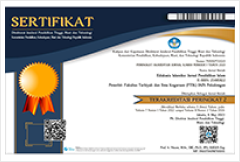The Leadership of Personnel Management in Islamic Education: Emerging Insights from an Indonesian University
DOI:
https://doi.org/10.28918/jei.v5i1.1057Keywords:
Leadership Style, Personnel Management, Islamic EducationAbstract
Leadership is one of crucial things in an education management. It also happens in Islamic higher education institutions, especially in the case of its personnel management. This study aims to describe the leadership style in a personnel management of an Islamic higher education institution in Yogyakarta, Indonesia. This study belongs to qualitative research by using interview and observation in collecting the data. The obtained data then validated by triangulation and descriptively analyzed to produce relevant interpretation of the data. This research comes into a conclusion that the education success is not only measured from the class management, curriculum, students and so on, but also its personnel management. This study promotes that leadership in personnel management of Islamic higher Education needs good leadership style which based on the principle of siddiq, amanah, tabligh, and fathonah. It can be applied through recruitment, development, promotion and transfer, dismissal, compensation, as well as evaluation of employee performance
References
Adair, J. (2004). Menjadi pemimpin Efektif. (Translated by Andre Asparsayogi). Jakarta: PT Pustaka Binaman Pressindo.
Ahammad, T. (2018). Personnel Management to Human Resource Management (HRM): How HRM Functions? Journal of Modern Accounting and Auditing,13(9), 412–420. doi:10.17265/1548-6583/2017.09.004
Aikaterini, G. (2014). Personnel Management vs. Human Resource Management: Evidence from Hellas. Thessalhoniki: International Hellenic University.
Alagaraja, M., Cumberland, D. M., & Choi, N. (2015). The mediating role of leadership and people management practices on HRD and organizational performance. Human Resource Development International, 7(2), 1-15. http://dx.doi.org/10.1080/13678868.2014.997139
Asrar-ul-Haq, M., & Kuchinke, K. P. (2016). Impact of leadership styles on employees’ attitude towards their leader and performance: Empirical evidence from Pakistani banks. Future Business Journal, 2, 54-64.
Bitsch, V. (2009). Personnel Management Research in Agribusiness. Michigan: Michigan State University.
Book, L., Gatling, A., & Kim, J. S. (2019). The effects of leadership satisfaction on employee engagement, loyalty, and retention in the hospitality industry. Journal of Human Resources in Hospitality & Tourism, 18(3), 368-393. https://doi.org/10.1080/15332845.2019.1599787
Dyer, L., &Burdick, W. E. (1998). Personnel and Human Resource Management Personnel and Human Resource Management. In J. McKelvey & M. Neufeld (Eds.),Industrial Relations at the Dawn of the New Millennium. New York: New York State School of Industrial and Labor Relations.
Fadjar, M. (2005). Holistika Pemikiran Pendidikan. Jakarta: Grafindo Persada.
Gyensare, M., Arthur, R., Twumasi,E., & Agyapong, J. (2019). Leader effectiveness – the missing link in the relationship between employee voice and engagement. Cogent Business & Management, 6(1), 1-21. https://doi.org/10.1080/23311975.2019.1634910
Handoko, T. H. (2005). Manajemen Personalia dan Sumber Daya Manusia. Jakarta: Liberti.
Knies, E., Leisink, P., & Schoot, R. V. (2017). People management: developing and testing a measurement scale. The International Journal of Human Resource Management, 12(2). 1-34. https://doi.org/10.1080/09585192.2017.137596
Mansir, F., & Karim, A. (2020). Islamic Education Learning Approaches in Shaping Students’ Emotional Intelligence in the Digital Age. Hayula: Indonesian Journal of Multidisciplinary Islamic Studies, 4(1), 67-86.https://doi.org/10.21009/004.01.04
Mulyasa,E. (2002). Manajemen Berbasis Sekolah: Konsep, Strategi, dan Implementasi, Bandung: PT Remaja Rosda Karya.
Nata, A. (2007). Manajemen Pendidikan: Mengatasi Kelemahan Pendidikan Islamdi Indonesia. Jakarta: Kencana.
Noe, R. A., Hollenbeck, J. R., Gerhart, B., & Wright, P. M. (2014). Fundamentals of human resource management. Michigan: Mc-Graw Hill.
Purnomo, H., Mansir, F., & Tumin, T. (2020). School relationship management with the community: analysis of program activity needs. Al-Asasiyya: Journal of Basic Education, 4(2), 161-172.
Pegg, M. (2004). Kepemimpinan Positif.(Translated by Arif Suyoko). Jakarta: PT PustakaBinaman Pressindo.
Qamar, M. (2007). Manajemen Pendidikan Islam: Strategi Baru Pengelolaan Lembaga Pendidikan Islam. Jakarta: Erlangga.
Rea, D. (2010). A contemporary definition of personnel management: Some of its critical assumptions and their relevance to the university organisation. Dublin: Journal of the Statistical and Social Inquiry Society of Ireland, XXII(V), 36-77.
Siagian, S. P. (2002). Manajemen Sumber Daya Manusia. Jakarta: Bumi Aksara.
Strauss, G., & Sayles, L. (2006). Manajemen Personalia.(Translated by Grace M. Hadikusuma & Rochmuliati Hamzah). Jakarta: PT Pustaka Binaman Pressindo.
Tiskevits, A. (2016). Personnel management in medium sized companies. Thesis, Degree Program in Industrial Management. Centria University of Applied Science.
Winardi, J. (2007). Manajemen Perilaku Organisasi. Jakarta: Kencana.






















